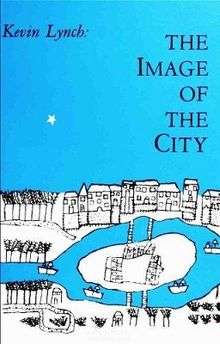The Image of the City
The Image of the City is a 1960 book by American urban theorist Kevin Lynch. The book is the result of a five-year study of Boston, Jersey City and Los Angeles on how observers take in information of the city, and use it to make mental maps. Lynch's conclusion was that people formed mental maps of their surroundings consisting of five basic elements.[1]
 First edition | |
| Author | Kevin Lynch |
|---|---|
| Language | English |
| Subject | Urban Planning, Architecture |
| Publisher | The MIT Press |
Publication date | 1960 |
| Pages | 194 pp. |
| ISBN | 0-262-62001-4 |
Imageability
Lynch argues that for any given city, a corresponding set of mental images exist in the minds of the people who experience that city. Contributing to those images are five qualities which Lynch identifies as Paths, Edges, Districts, Nodes, and Landmarks.[1]
- Paths
- Edges
- Boundaries
- They can be either Real or Perceived
- These are walls, buildings, and shorelines, curbstone, streets, overpasses, etc.
- Districts
- Medium to large areas that are two-dimensional
- An individual enters into and out of these areas
- Have common identifying characteristics
- Nodes
- Large areas you can enter, serve as the foci of the city, neighborhood, district, etc.
- Offers the person in them multiple perspectives of the other core elements
- "...the most successful node seemed both to be unique in some way and at the same time to intensify some surrounding characteristic"[1]:77
- Landmarks
- Points of reference person cannot enter into
- These are buildings, signs, stores, mountains, public art
- At least one aspect of them is unique or memorable in the context they exist
- Mobile Points (such as Sun) can be used as well
Influence
The Image of the City has influenced the fields of environmental psychology and environmental behavior as well as a generation of researchers working within them. Researchers that include Amos Rapoport, Claire Cooper Marcus, Oscar Newman, William H. Whyte, Kenneth Craik and Donald Appleyard. [2]
References
- Lynch, Kevin (1960). The Image of the City. The MIT Press. ISBN 0-262-62001-4.
- The urban design reader. Larice, Michael, 1962-, Macdonald, Elizabeth, 1959- (Second ed.). London. 2013. ISBN 978-0-203-09423-5. OCLC 1139281591.CS1 maint: others (link)